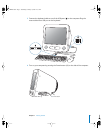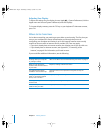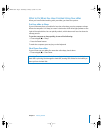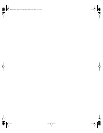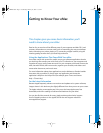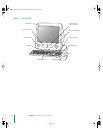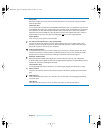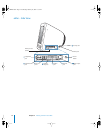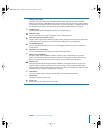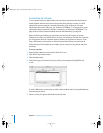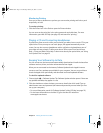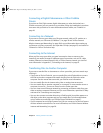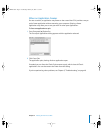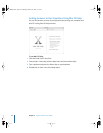
Chapter 2 Getting to Know Your eMac 15
Memory access (inside)
Your eMac comes with at least 256 megabytes (MB) of Double Data Rate Synchronous Dynamic
Random Access Memory (DDR-SDRAM). There are two memory slots, one of which is usually available
for expansion. The maximum amount of memory you can have in your eMac is 1 gigabyte (GB), using
two 512 MB memory modules. For instructions, see “Installing Additional Memory” on page 37.
f
Headphone port
Connect external speakers, headphones, or other sound output devices.
Audio line in port
Connect your eMac to a line-level microphone or other audio equipment.
Three USB (Universal Serial Bus) 2.0 ports
Connect printers, Zip and other disk drives, digital cameras, joysticks, and more. Connect original USB
1.1 and high-speed USB 2.0 devices. (There are also two USB 1.1 ports on your keyboard.)
Two FireWire 400 ports
Connect high-speed external devices, such as an iPod, digital videocameras, printers, and external
storage devices.
W
Modem port (on some models)
Connect a standard phone line directly to the internal 56K v.92 modem.
G
Ethernet port (10/100Base-T)
Connect to a high-speed 10/100Base-T Ethernet network, a DSL or cable modem, or connect to
another computer and transfer files. The Ethernet port auto-sensing feature detects other Ethernet
devices. You don’t need an Ethernet crossover cable to connect to other Ethernet devices.
Video out port
Using the optional Apple VGA Display Adapter (available at www.apple.com/store), connect to an
external monitor or projection device that uses a VGA connector. Using the optional Apple Video
Adapter (available at www.apple.com/store), connect your eMac to a television, VCR, or another video
device that uses an S-video or composite video connector.
®
Power button
Turn on your eMac or put it to sleep. Press and hold to reset during troubleshooting.
≤
Power socket
Connect the computer’s power cord.
Security slot
Protect your eMac by connecting a security cable.
LL2522.book Page 15 Wednesday, February 18, 2004 11:53 AM



